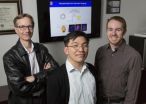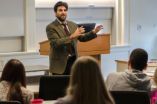(Press-News.org) As a human race we strive for perfection, knowing that no one is perfect. A new study in the Journal of Consumer Research offers insight into why we surround ourselves with people who help bring out our best but don't make us feel terrible when we stray from perfection.
"In a situation requiring two people to use self-control, either both indulge, both abstain, or one indulges while the other abstains. Our research looks at how these different outcomes impact people who are friends," write authors Michael L. Lowe (Texas A&M University) and Kelly L. Haws (Vanderbilt University).
In one study, the authors randomly grouped individuals into pairs and placed them in a room with instructions to watch and evaluate a short film. A bowl of candy was placed on a table between the two participants and a hidden camera was used to monitor if (and how) the candy was consumed. Participants who ate just a few candies each later reported liking their partner more than when the study began. Conversely, participants who said they ate too much candy reported liking their partner less than when the study began.
Results show that matched decisions, whether in virtue or vice, typically result in enhanced affiliation between the decision makers. However, the type of matched decision that provided the biggest boost in affiliation depended on how serious the consequences were perceived to be. When the stakes were high, people bonded through moral support. When the consequences were a little less severe, people improved their friendship through partnering in crime.
Understanding that consumers prefer to make small indulgences in pairs can help brands offering 'friends and family' promotions. Public policymakers can also benefit from the understanding that as perceived severity increases, so too do the social benefits of mutually abstaining from behaviors like overspending, drug use, or overeating.
"Our findings provide insights into how consumers can most effectively use others for accountability in trying to achieve important goals, while potentially enhancing their well-being through managing guilt and being able to enjoy smaller indulgences in the company of friends," the authors conclude.
INFORMATION:
Michael L. Lowe and Kelly L. Haws. "(Im)moral Support: The Social Outcomes of Parallel Self-Control Decisions." Journal of Consumer Research: August 2014. For more information, contact Michael Lowe or visit http://ejcr.org/.
Partners in crime: When do friends conspire to eat more chocolate?
2014-05-21
ELSE PRESS RELEASES FROM THIS DATE:
Shopping online: Why do too many photos confuse consumers?
2014-05-21
When shopping online, we often have the option of clicking on additional product photos taken from different angles or showing additional features. According to a new study in the Journal of Consumer Research, looking at more photos when making product comparisons can ultimately inhibit us from noticing what differentiates them in the first place.
"The intuition that 'seeing more is always better' does not consider the possibility that when presented with too many product photos, the way we process information is altered," write authors Jayson Shi Jia (University of ...
UNC researchers find new target for chronic pain treatment
2014-05-21
CHAPEL HILL, N.C. (May 21, 2014) – Researchers at the UNC School of Medicine have found a new target for treating chronic pain: an enzyme called PIP5K1C. In a paper published today in the journal Neuron, a team of researchers led by Mark Zylka, PhD, Associate Professor of Cell Biology and Physiology, shows that PIP5K1C controls the activity of cellular receptors that signal pain.
By reducing the level of the enzyme, researchers showed that the levels of a crucial lipid called PIP2 in pain-sensing neurons is also lessened, thus decreasing pain.
They also found a compound ...
Cancer avatars for personalized medicine
2014-05-21
Researchers at University of California, San Diego School of Medicine and Moores Cancer Center have used computer simulations of cancer cells – cancer avatars – to identify drugs most likely to kill cancer cells isolated from patients' brain tumors.
The findings, published in May 21 online issue of the Journal of Translational Medicine, may help researchers stratify cancer patients for clinical trials according to their cancers' genomic signatures and predicted sensitivities to different cancer drugs.
Such an approach would allow scientists to selectively test cancer ...
Rhythmic bursts of electrical activity from cells in ear teach brain how to hear
2014-05-21
PITTSBURGH, May 21, 2014 – A precise rhythm of electrical impulses transmitted from cells in the inner ear coaches the brain how to hear, according to a new study led by researchers at the University of Pittsburgh School of Medicine. They report the first evidence of this developmental process today in the online version of Neuron.
The ear generates spontaneous electrical activity to trigger a response in the brain before hearing actually begins, said senior investigator Karl Kandler, Ph.D., professor of otolaryngology and neurobiology, Pitt School of Medicine. These patterned ...
NIH Pain Consortium's first pain care curriculum improves clinical skills
2014-05-21
An online training module designed for the evaluation and care of chronic pain greatly improved medical student clinical skills, according to a report in the Journal of the American Geriatrics Society. The module, built by the University of Pittsburgh and using an elderly woman with chronic lower back pain as a case study, is the first curriculum resource created through the efforts of the National Institutes of Health Pain Consortium's Centers of Excellence in Pain Education program (CoEPEs). The program was developed in response to the Affordable Care Act's mandate to ...
Illinois researchers combine weak chemical forces to strengthen novel imaging technology
2014-05-21
When University of Illinois Associate Professor of Chemical and Biomolecular Engineering Hyunjoon Kong, graduate student Cartney Smith, and colleagues set out to improve MR imaging (MRI), they turned current contrast agent technology on its head—or rather, they turned it inside out. The new compound they designed in collaboration with Illinois' Roger Adams Professor of Chemistry Steven C. Zimmerman is not only more effective, but also self-assembling. Kong is also a member of the Regenerative Biology and Tissue Engineering research theme at the Institute for Genomic Biology.
When ...
New study reveals corporate social responsibility can lead to better customer service
2014-05-21
Currently accepted wisdom in the corporate world is that in order to motivate frontline employees who serve customers, corporations need to increase their salary, make them feel more positive about the company, or give them more explicit instructions on how to interact with customers. A new study led by Drexel University's Daniel Korschun, PhD, an assistant professor at the LeBow College of Business, examines how frontline employees respond to corporate social responsibility (CSR) activities such as charitable giving, environmental programs and ethical practices. The study ...
New guidelines and technology needed for placement of feeding tubes in pediatric patients
2014-05-21
Universal guidelines and improvements in technology are needed to reduce injuries and deaths from improper placement of nasogastric feeding tubes in pediatric patients, according to a comprehensive review of published literature.
The review, conducted by the New Opportunities for Verification of Enteral Tube Location (NOVEL) Work Group Project of the American Society for Parenteral and Enteral Nutrition (A.S.P.E.N.) found that while the bedside placement of a nasogastric feeding tube is a common procedure conducted by nurses, incorrect placement can have serious and ...
New, fossil-fuel-free process makes biodiesel sustainable
2014-05-21
EAST LANSING, Mich. — A new fuel-cell concept, developed by an Michigan State University researcher, will allow biodiesel plants to eliminate the creation of hazardous wastes while removing their dependence on fossil fuel from their production process.
The platform, which uses microbes to glean ethanol from glycerol and has the added benefit of cleaning up the wastewater, will allow producers to reincorporate the ethanol and the water into the fuel-making process, said Gemma Reguera, MSU microbiologist and one of the co-authors.
"With a saturated glycerol market, traditional ...
Risky alcohol use in male-dominated industries
2014-05-21
New Rochelle, NY, May 21, 2014—The workplace can provide an ideal environment to implement support, well-being, and testing interventions aimed at reducing risky alcohol use among men. By targeting male-dominated industries, in particular, alcohol screening and prevention efforts may be effective in reducing alcohol use, according to a Review article in Journal of Men's Health, a peer-reviewed publication from Mary Ann Liebert, Inc., publishers. The article is available free on the Journal of Men's Health website.
A team of Australian researchers led by Nicole Lee, ...





